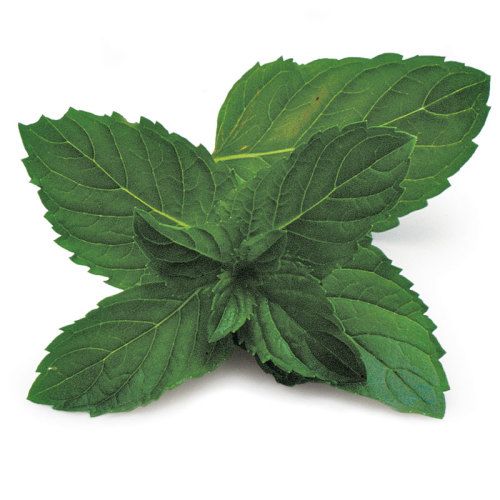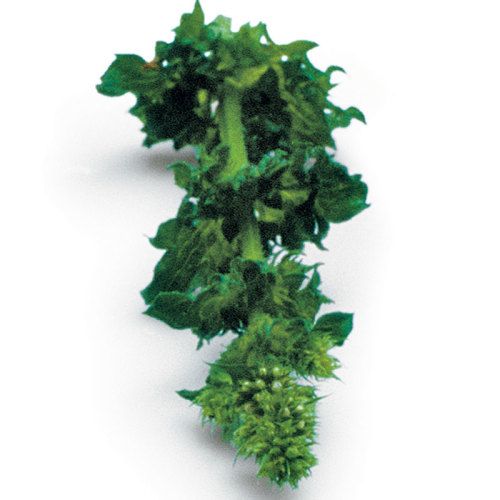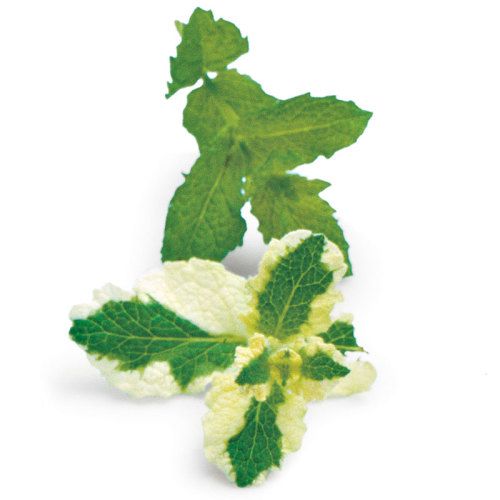
When I think of mint, the first thing that enters my mind is its inimitable fragrance. One whiff of a crushed mint leaf and menthol fills my nose with a coolness that invigorates me, opening my sinuses, awakening my senses, and clearing out the cobwebs in my mind.
Just the thought of mint in my mouth makes my tongue tingle. Peppermint penetrates the taste buds with a lively pepperiness; spearmint permeates them with a subtle sweetness. Mention mint and I think of tea. This soothing beverage is so simple-just mint leaves infused in boiling water. Mint takes me to a casbah in Marrakech, sipping hot, sweet tea poured from an ancient copper pot into gold-rimmed glasses.
Mint is exotic and yet a part of our everyday lives. Can you imagine growing up in America without tasting chocolate chip mint ice cream? What would tabbouleh be without mint? And what of our grandparents and the mint candies hidden in their pockets or set out on the coffee table? Menthol, which gives mint its well-known scent and flavor, is found in foods and medicines worldwide. It’s used commercially in toothpaste, chewing gum, and mouthwash. Menthol has soothed many a stomach, and it’s an antiflatulent to boot.
Varieties to savor in the kitchen
There are about 25 well-defined species in the genus Mentha, and there are more than 500 named varieties. Many of these are variants or hybrids of the 25 species, demonstrating mint’s tendency to hybridize readily. All mints have square, branching stems and oval or lance-shaped leaves with finely serrated edges. All contain volatile oils that create the aromas mints are known for. My three favorites for cooking are peppermint, spearmint, and orange or bergamot mint.
Peppermint (Mentha x piperita ‘Mitcham’). The best-tasting peppermint is found under various names throughout the country: ‘Mitcham’, black-stemmed, ‘Blue Balsam’, and even chocolate mint. It is highly mentholated, almost hot, and full of flavor. The plant has a deep purple-blue cast to the stem, and the leaves are a bit larger and rounder than those of other peppermints. Its strong taste holds up well in cooked dishes. It’s also good in drinks and desserts where you want intense flavor. Chocolate mint works well with chocolate-in cookies, cakes, brownies, and ice cream.
 |
 |
 |
||
| ‘Blue Balsam’ peppermint. | ‘Curly’ mint. | Spearmint (top) and ‘Variegated Pineapple’ mint. | ||
 |
|
| From top: ‘Kentucky Colonel’ spearmint, ‘Hillary’s Sweet Lemon Mint’, orange mint, ‘Emerald Gold’ spearmint. | |
 |
|
| Applemint. | |
Spearmint (Mentha spicata). There are many kinds of spearmints; most have hairy leaves that are a light, bright green. Spearmint is milder and sweeter than peppermint and makes wonderful mint tea, sauces, and jellies. It is the mint I choose for fresh pea soup and broiled summer tomatoes. Because spearmint is similar to the mint found in the Mediterranean, I use it when I prepare dishes characteristic of that region: rice salad, couscous, and tabbouleh. I also like to candy the small leaves for desserts. ‘Curly’ mint (Mentha spicata ‘Crispa’) is sweet and fragrant, with curly leaves. Use it in the same manner as the other spearmints. ‘Kentucky Colonel’ is a mild-mannered spearmint. Put it in a mint julep or any summertime beverage.
Orange mint (Mentha aquatica). This attractive plant has small, oval, bright-green leaves and small, lavender blossoms that make a tasty edible flower. Orange mint’s intense perfume, which is reminiscent of Earl Grey tea, boosts its strong citrus flavor. It is delicious with fruits, especially the stone fruits of summer like peaches, nectarines, plums, and apricots, and it works well in drinks, sauces, preserves, and desserts.
Double Mint (Mentha x gracilis ‘Madalene Hill’).This plant was brought to herb authority Madalene Hill in the mid- to late-1960s from Southeast Asia and was originally called red-stem applemint. This remarkable natural hybrid is a wonderful and unusual mint, packed with the fragrance and flavor of both spearmint and peppermint.
Applemint (Mentha suaveolens). This fuzzy-leaved mint, which comes in both green and variegated types, has a mild flavor and a very slight applelike aroma. It’s good with fruit salads, in beverages, or as a garnish.
Ginger mint (Mentha x gentilis ‘Variegata’). Ginger mint adds zest to cool summer soups and vinaigrettes. It is tasty in baked goods like scones and gingerbread, and it is good in beverages, from tea to lemonade and fruit punch.
Yerba Buena (Satureja douglasii). This plant with its pale-green, minty leaves is found in Latin America, Mexico, and the southwestern United States, where it is used in tea, soups, stews, and desserts.
Growing mint
Mint has a reputation as a bit of a rambunctious traveler; plainly put, it can be an aggressive spreader. That shouldn’t dissuade you from growing it, as there are ways of dealing with mint’s waywardness. First, think carefully about where you plant mint because it will send out runners and propagate quickly. Put it where you don’t mind its spreading tendency, or contain it in pots, tubs, or even chimney flues.
| Want to grow mint but only if it stays within bounds? Read Containing Mint at FineGardening.com for strategies for keeping this aggressive grower on its best behavior. | |
Since planting mint from seed is variable, it’s best to buy plants from a reputable source or to propagate mint from stem or root cuttings. (Try Richters Herbs or The Thyme Garden.) Propagating mint is easy to do, and you can be sure of getting what you see. Mints hybridize readily, so it’s often difficult to identify the many variations.
Once you have an established plant, mint is easy to care for: It needs water, good drainage, and well-fertilized soil. It does best in full sun in most climates, but it will grow in partial shade, especially in hot, dry areas.
Cut stems as you need them during the growing season. When the plants begin to flower, harvest the whole plant to use fresh or dry.
Fresh ways to use mint
Mint brightens just about any dish, from a couscous salad to new potatoes tossed with mint and shallots, from lamb with a mint jelly glaze to homemade peppermint ice cream. For a refreshing touch, rub the leaves around the rim of an iced tea or lemonade glass before serving. Keep freshly cut stems in a glass or vase of water on the kitchen counter and you’ll have mint leaves at your fingertips when you need them. They last a good week this way, specially if you change the water every few days. In fact, the stems might even start to root.
To prepare fresh mint leaves for a recipe, rinse the leaves and stems and pat or spin them dry. Remove any spotted or bug-eaten leaves. Keep fresh-cut stems in water until ready to use, then remove the leaves from the stems. This can be done a few hours in advance, if necessary, and the leaves can be kept in a slightly dampened paper towel in a plastic bag in the refrigerator. Chop the leaves just before you are ready to use them, because they will darken and lose flavor once they are cut, just like basil leaves.
In early spring and summer, I like to add very small, whole mint leaves to salads. Since they are little, I don’t chop them, and when you bite into them they give a surprise burst of flavor.
Create new flavors in some of your old standby recipes by adding mint. Add 1⁄4 to 1⁄2 cup of chopped mint leaves to your favorite chocolate or yellow cake recipe; the result will be a refreshing new taste. Or, try adding 1⁄2 cup finely chopped orange mint or peppermint to your sugar cookie dough before rolling it out. Add tiny mint leaves to a green salad for a pleasant zing or use some in a vinaigrette.
For a tasty dressing for fresh fruit, combine 2 cups vanilla yogurt with 1⁄4 cup fresh orange juice, 1 tablespoon lemon juice, and 3 tablespoons minced orange mint. This simple and delicious dressing can be made ahead and kept in the refrigerator until you’re ready to use it. Vary the dressing a little by using different mints. Don’t be afraid to experiment.
|
Mint tea, Moroccan style To brew mint tea Moroccan-style, you’ll need a tea kettle to boil water in, a teapot, some green tea leaves, and a bunch of fresh spearmint. Put the water in the kettle on to boil, and rinse the teapot with hot water to warm it. Add 1 teaspoon green tea leaves or one tea bag per person to the teapot. Rinse fresh spearmint, if necessary, and add enough to fill the pot at least half full of spearmint leaves. When it boils, add water to the pot, one cup per person, along with about 2 teaspoons of sugar per person. Stir and cover. You can use less sugar, but traditionally this tea is served very sweet. Let the tea steep for 5 to 10 minutes. Put a fresh sprig of spearmint in each cup and pour the tea. Get the complete recipe… |
Dry mint for year-round use
To dry mint, cut the stems and tie them together in bunches, then hang them in a shady place with good air circulation. To dry small amounts, strip the leaves from the stems and spread them on screens or flat baskets. Keep the drying leaves out of direct sunlight and away from moisture. They should dry in a week to 10 days. You can tell the leaves are dry if they crackle when rubbed between your fingers; if they are pliable, they still have moisture in them. Pack completely dried whole leaves in glass jars and store away from direct light. To make a delicious dried mint tea, use equal parts peppermint, spearmint, and orange mint.
The ratio for substituting dried mint for fresh is about one to three; in other words, if a recipe calls for 3 tablespoons fresh mint, you would substitute 1 tablespoon dried mint leaves. The volatile oils are much stronger in a dried herb than in a fresh herb, since all of the moisture has evaporated. It is best to dry or buy whole mint leaves and crumble them into the dish you are making just before using. When you crush a dried herb leaf you release the essential oils, which you want to flavor the dish.
When using dried mint, the menthol comes through, but the subtle fragrance and flavor nuances are missing. Nevertheless, you can use dried mint successfully in tabbouleh, salads, dressings, teas, and baked goods. Dry or fresh, mint’s cool flavor goes a long way in food and drink.
Read more articles on growing herbs…
by Susan Belsinger
August 1999
from issue #22
Fine Gardening Recommended Products

Gardener's Log Book from NYBG
Fine Gardening receives a commission for items purchased through links on this site, including Amazon Associates and other affiliate advertising programs.

A.M. Leonard Deluxe Soil Knife & Leather Sheath Combo
Fine Gardening receives a commission for items purchased through links on this site, including Amazon Associates and other affiliate advertising programs.

Berry & Bird Rabbiting Spade, Trenching Shovel
Fine Gardening receives a commission for items purchased through links on this site, including Amazon Associates and other affiliate advertising programs.






















Comments
Log in or create an account to post a comment.
Sign up Log in